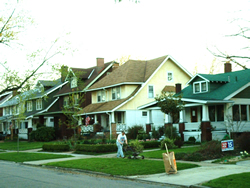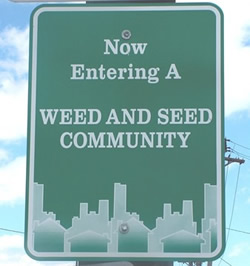
Design features such as front porches and windows that put ?eyes on the street? can make a significant and long-term contribution to improving neighborhood safety. | SAFETY
GOAL: Improve public safety through safety-conscious design and through community-based solutions focused on crime prevention
Issues
Safety is the most fundamental characteristic of a desirable neighborhood. Nothing is more important to the well-being of residents than safety. The job of creating safe neighborhoods, however, cannot rest solely on police and fire and EMS officers. It takes the efforts of residents, businesses, judges, teachers, social workers and a host of others. City planning has an important but often overlooked role to play, particularly in the critical area of crime prevention.
The design and layout of developments can help prevent crime or can make crime more likely. Areas hidden from view work to the advantage of criminals; areas open to public view and surveillance work to the advantage of residents, shoppers and employees. Similarly, poorly lit areas work to the advantage of criminals, while well-lit areas work to the advantage of the public.
Just as important in preventing crime is action by the community to organize against crime. Merchants’ associations, block clubs and other groups, working in partnership with the police, can play a critical role in sending a message to criminals that their presence will not be tolerated. These same groups are working with local government and the courts to control and eliminate the dilapidated vacant buildings that are havens for drug trafficking and other crimes, while targeting other high-crime areas for additional police presence. |

Communities organizing against crime send the signal that criminal activity will not be tolerated. [sign for program to ?weed? out crime and ?seed? positive activities] |
Policies
- Safety by Design. Incorporate “safety-by-design” standards in local zoning codes, building codes, master plans, and design review guidelines.
- Design Features. Use safety-by-design standards to require adequate lighting, areas open to surveillance, window and porches along public streets, and safe pedestrian circulation systems.
- Business District Patrols. Work with merchant associations and local development corporations to institute security patrols in neighborhood and regional business districts.
- Police Presence. Continue collaboration between the police and community groups to ensure greater police presence in areas experiencing increased criminal activity, and consider such programs as those that allow officers to take patrol cars home for increased visibility in residential areas.
- Technology. Increase the efficiency of policing through use of such technology as video surveillance cameras, GIS mapping and data systems, and improved access to such information from police vehicles.
- Public Education. Expand programs to educate residents and businesses on safety precautions and crime deterrence, while providing information to counter inaccurate perceptions of crime levels in Cleveland’s neighborhoods and downtown.
|





